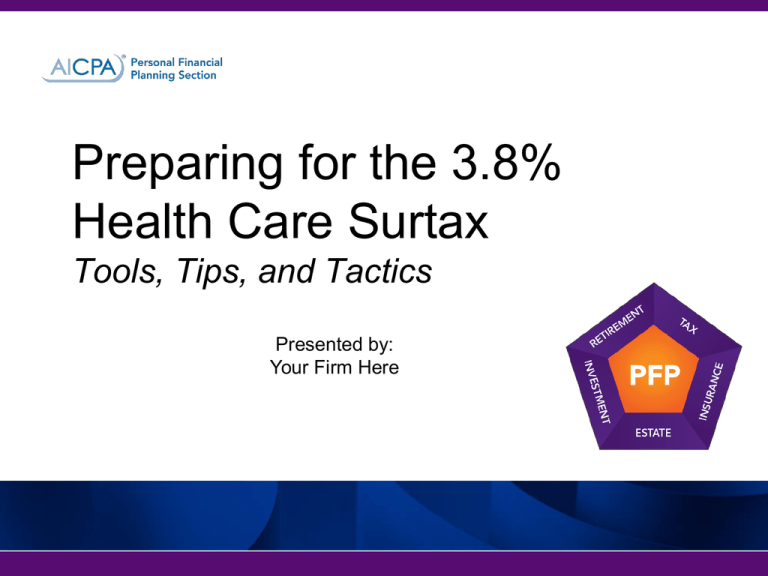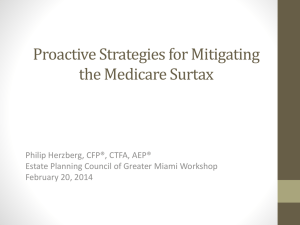
Preparing for the 3.8%
Health Care Surtax
Tools, Tips, and Tactics
Presented by:
Your Firm Here
Patient Protection and Affordable Care Act
Supreme Court upheld the proposed tax increases that were part of the Patient
Protection and Affordable Care Act (as amended by the Health Care and Education
Reconciliation Act of 2010) (“ACT”).
While certain elements of the legislation have already begun to take effect, some
won’t begin until January 1, 2013.
TAX ON EARNINGS
Today, workers pay 1.45% of their wages into Medicare.
Starting next year, high-income individuals will pay another 0.9 percentage points
on their earned income over $200,000 ($250,000 if married).
INVESTMENT INCOME
To date has never been subject to the Medicare tax.
Starting next year, high-income households will start paying a 3.8% surtax on at
least a portion of their investment income, such as capital gains, dividends, and
rental income.
Personal Financial Planning Section
2
Tax on Earnings
An additional
0.9% surtax
on higher income
households
The tax applies to wages and
self-employment income in
excess of threshold.
THRESHOLDS
Single
taxpayers
$200,000
Married $250,000
taxpayers
filing jointly
There is no employer match on the
0.9 percent tax.
Personal Financial Planning Section
3
Tax on Earnings - Example
Ron
.9%surtax
surtax
.9%
› Single taxpayer
› Self-employed
› $500,000 earnings
would
would
Excess of
Earnings
Threshold
$500,000
-$200,000
= $300,000
Personal Financial Planning Section
APPLY
APPLY
to$300,000
$300,000
to
==
$2,700
$2,700
additional
additional
tax
tax
4
3.8% Medicare Surtax - Overview
Investment Income
Beginning with the 2013 tax year, a new 3.8%
Medicare “surtax” will apply to all taxpayers whose
income exceeds a certain “threshold amount”. This
new “surtax” will, in essence, raise the marginal
income tax rate for affected taxpayers.
Thus, a taxpayer in the 39.6% tax bracket (i.e. the
highest marginal income tax rate in 2013) would
have a marginal rate of 43.4%!
Personal Financial Planning Section
5
3.8% Medicare Surtax - Overview
Current Tax
Rate
Tax Rate in
2013+
Tax Rate in
2013+
(w/surtax)
10%
15%
25%
28%
33%
35%
15%
15%
28%
31%
36%
39.6%
15%
15%
28%
34.8%
39.8%
43.4%
NOTE: The chart above assumes that the 3.8% Medicare surtax would not begin to
apply until a person’s taxable income reaches the 31% tax bracket (based on certain
net investment income and itemized deduction assumptions). However, there are
times when the 3.8% could apply to a person in a lower tax bracket (i.e. 15%, 28%) or
may not apply to a person in higher tax brackets (31%, 36%, 39.6%).
Personal Financial Planning Section
6
3.8% Medicare Surtax - Overview
APPLICATION TO INDIVIDUALS
The Medicare Surtax is equal to:
1. “Net
Net investment
Investment Income”
Income
3.8% X
the lesser of
OR
OR
2.
2. The
Theexcess
excess(if(ifany)
any)ofof––
-- ““Modified
Modified Adjusted
Adjusted Gross
Gross Income
--
Personal Financial Planning Section
(MAGI)
Income (MAGI)
“Threshold
“Thresholdamount”
Amount”
7
3.8% Medicare Surtax - Overview
APPLICATION TO ESTATES AND TRUSTS
The Medicare Surtax is equal to:
3.8% X
the lesser of
1. “Net
Undistributed
investment“net
Income”
investment
income” for such taxable year
OR
OR
2.
2. The
Theexcess
excess(if(ifany)
any)ofof––
-- ““Adjusted
Modified Adjusted
Gross Income
Gross Income”
(as defined in
-
(MAGI)
section 67)) for such taxable year, over
“Threshold
amount”at which the highest
the dollar amount
tax bracket in section 1(e) begins for
such a taxable year
Personal Financial Planning Section
8
3.8% Medicare Surtax - Overview
Three critical terms associated with the 3.8% Medicare
Surtax:
Net Investment Income
Threshold Amount
Modified Adjusted Gross Income (MAGI)
Personal Financial Planning Section
9
3.8% Medicare Surtax - Overview
NET INVESTMENT INCOME
Includes:
Does NOT Include:
•
Interest
•
Salary, wages, or bonuses
•
Dividends
•
Distributions from IRAs or qualified plans
•
Annuity Distributions
•
Any income taken into account for selfemployment tax purposes
•
Rents
•
•
Royalties
Gain on the sale of an active interest in a
partnership or S corporation
•
Income derived from passive
activity
•
•
Net capital gain derived from the
disposition of property
Items which are otherwise excluded or
exempt from income under the income
tax law, such as interest from tax-exempt
bonds, capital gain excluded under IRC
121, and veterans benefits
Personal Financial Planning Section
10
3.8% Medicare Surtax - Overview
Types of Income Subject to Surtax
Subject to Surtax:
Exempt from Surtax:
•
•
•
•
•
•
•
•
•
•
•
•
•
Taxable Interest
Dividends
Annuity Income
Passive Royalties
Rents
Personal Financial Planning Section
Wages
Exempt Interest
Active Royalties
IRA Distributions
401(k) Distributions
Pension Income
RMDs
Social Security Income
11
3.8% Medicare Surtax - Overview
“Threshold Amount:” the key factor in determining the
“lesser of” formula for purposes of calculating the
surtax.
Threshold Amounts:
Single taxpayers - $200,000
Married taxpayers - $250,000
Estates/Trusts - $11,650 (i.e. top income tax bracket
in 2012)
Personal Financial Planning Section
12
3.8% Medicare Surtax - Overview
“Modified adjusted gross income” (MAGI): the amount
that is compared to the “threshold amount” to
determine the “net investment income” that is subject
to the surtax.
MAGI equals:
Adjusted gross income (i.e., Form 1040, Line 37) PLUS
Net foreign earned income exclusion (i.e. gross income
excluded under the foreign earned income exclusion less
certain deductions or exclusions that were disallowed
due to the foreign earned income exclusion
Personal Financial Planning Section
13
3.8% Medicare Surtax - Overview
Example 1
John
• Single Taxpayer
• $100,000 of Salary
• $50,000 net investment
income
MAGI is $150,000
Personal Financial Planning Section
3.8% Surtax
would
NOT apply
MAGI is less
than
threshold
14
3.8% Medicare Surtax - Overview
Example 2
Linda
• Single taxpayer
• $0 employment income
• $225,000 net investment
income
Excess of
MAGI
Threshold
3.8% Surtax
would apply
to
$25,000
$225,000
-$200,000
= $25,000
Personal Financial Planning Section
15
3.8% Medicare Surtax - Overview
Example 3
Tina & Terry
• Married, filing jointly
• $300,000 combined
salary
• $0 net investment income
Personal Financial Planning Section
3.8% Surtax
would
NOT apply
Wages
Exempt
16
3.8% Medicare Surtax - Overview
Example 4
Peter & Paula
• Married, filing jointly
• $400,000 salary income
• $50,000 net investment
income
Personal Financial Planning Section
3.8% Surtax
would apply
to
$50,000
17
3.8% Medicare Surtax - Overview
Example 5
Sarah & Scott
• Married, filing jointly
• $200,000 salary income
• $150,000 net investment
income
Excess of
MAGI
Threshold
3.8% Surtax
would apply
to
$100,000
$350,000
- $250,000
=$100,000
Personal Financial Planning Section
18
3.8% Medicare Surtax - Overview
Example 6
Randy – Age 70
• Single taxpayer
• $200,000 investment
income
• $125,000 RMD from his
IRA
Excess of
MAGI
Threshold
3.8% Surtax
would apply
to
$125,000
$325,000
- $200,000
=$125,000
Personal Financial Planning Section
19
3.8% Medicare Surtax - Overview
Example 7
David & Veronica
• Married, filing jointly
• $100,000 pension
income
• $150,000 IRA income
• $25,000 tax-exempt
interest
• $0 net investment income
Personal Financial Planning Section
3.8% Surtax
would NOT
apply
20
Planning Around the Surtax
Strategies for Reducing “Net Investment Income”
Municipal Bonds
Tax-deferred annuities
Life insurance
Rental real estate
Oil & Gas investments
Choice of accounting year for estate/trust
Timing of estate/trust distributions
Personal Financial Planning Section
21
Planning Around the Surtax
Strategies for Reducing “Net Investment Income”
Municipal Bonds Example:
Jacob, a single taxpayer, on average has $180,000 of salary income,
$5,000 of interest income and $15,000 of dividend income each year.
Recently, Jacob inherited $1,000,000 from his uncle and has determined
that he would like to invest the money either in: (a) taxable corporate
bonds earning 7% or (b) tax-exempt municipal bonds earning 4.5%.
Assuming that Jacob is in the 36% marginal income tax bracket for the
2013 tax year and lives in a state without an income tax, below is a
summary of the after-tax yield on each investment:
Corporate bond
4.214%
{7% x [1 – (36% + 3.8%)]}
Personal Financial Planning Section
Municipal bond
4.5%
22
Planning Around the Surtax
Strategies for Reducing “Net Investment Income”
Tax-deferred Annuity Example:
Lisa, a single taxpayer, has recently been approached by her financial advisor to
consider investing in a tax-deferred non-qualified annuity. At the advice of her
CPA, Lisa decided to invest $500,000 in a tax- deferred non-qualified annuity
earning 5% per year. Assuming that Lisa has $200,000 of gross income and is in
the 28% tax bracket for the next 10 years, below is a summary of the tax savings
achieved by investing in a tax-deferred non-qualified annuity versus investing in a
non-qualified diversified investment portfolio (i.e. a taxable brokerage account)
earning 6% interest per year on a pre-tax basis.
Taxable Brokerage Account
Year
1
2
3
4
5
6
7
8
9
10
Beginning
Balance
$ 500,000
$ 520,460
$ 541,757
$ 563,926
$ 587,002
$ 611,022
$ 636,025
$ 662,051
$ 689,142
$ 717,342
Income @
6%
$ 30,000
$ 31,228
$ 32,505
$ 33,836
$ 35,220
$ 36,661
$ 38,161
$ 39,723
$ 41,349
$ 43,041
Income Tax
@ 31.8%
$ (9,540)
$ (9,930)
$ (10,337)
$ (10,760)
$ (11,200)
$ (11,658)
$ (12,135)
$ (12,632)
$ (13,149)
$ (13,687)
Ending
Balance
$ 520,460
$ 541,757
$ 563,926
$ 587,002
$ 611,022
$ 636,025
$ 662,051
$ 689,142
$ 717,342
$ 746,696
Tax-Deferred Non-Qualified Annuity
Beginning
Balance
$ 500,000
$ 525,000
$ 551,250
$ 578,813
$ 607,753
$ 638,141
$ 670,048
$ 703,550
$ 738,728
$ 775,664
Income @
5%
$ 25,000
$ 26,250
$ 27,563
$ 28,941
$ 30,388
$ 31,907
$ 33,502
$ 35,178
$ 36,936
$ 38,783
Income Tax
@ 0.00%
$
$
$
$
$
$
$
$
$
$
-
Ending
Balance
$ 525,000
$ 551,250
$ 578,813
$ 607,753
$ 638,141
$ 670,048
$ 703,550
$ 738,728
$ 775,664
$ 814,447
Difference
$
4,540
$
9,493
$ 14,887
$ 20,751
$ 27,119
$ 34,023
$ 41,499
$ 49,586
$ 58,322
$ 67,752
NOTE: The 31.8% income tax rate in the taxable brokerage account scenario is the sum of Lisa’s marginal
income tax rate (28%) plus the 3.8% surtax because her gross income was over the threshold amount.
Personal Financial Planning Section
23
Planning Around the Surtax
Strategies for Reducing “Net Investment Income”
Life Insurance Example
Tim, a married filing jointly taxpayer, recently paid a $250,000 single
premium to purchase a $2,000,000 second-to-die whole-life policy. At
the end of Year 10, Tim withdrew $50,000 from the policy’s cash value
when it was worth $450,000.
Given these facts, none of the $200,000 of earnings to-date ($450,000
current cash value - $250,000 initial premium), or any future earnings
within the life insurance policy, are subject to the 3.8% surtax until
Tim withdraws more than his initial single premium amount.
Further, even if Tim withdraws earnings from the life insurance policy
in a future tax year, none of the earnings will be subject to the 3.8%
surtax, provided that Tim’s MAGI (which would include the earnings
withdrawn from the life insurance policy) is below the “threshold
amount” (i.e. $250,000 for married-filing-jointly taxpayers).
Personal Financial Planning Section
24
Planning Around the Surtax
Strategies for Reducing “Net Investment Income”
Rental Real Estate Example
Jerry & Mary, married filing jointly taxpayers, have$50,000 of net royalty income annually from a gas well in
Wyoming. In addition, Jerry has $100,000 in wages, Mary has $75,000 in wages and the both of them have
$30,000 in dividend income each year.
At the end of 2012, Jerry & Mary invested $275,000 into a residential real estate property. Based on past
results, on average the property value increases by about 3.5% per year and the rental brings in about $5,000
of net income before depreciation. Assuming that the property is depreciated over a 27½-year life, the
$275,000 investment will produce a $10,000 annual depreciation expense, resulting in a net rental loss of
$5,000. This resulting net rental loss can then be used to offset Jerry & Mary’s net royalty income. Assuming
that Jerry and Mary are in the 31% income tax bracket in 2013, below is a summary of the return on investment
earned by Jerry & Mary’s from their rental real estate property.
Property appreciation
Net cash flow from rental
Income tax savings from rental loss
Surtax savings from rental loss
Total return on investment
Total return on investment (%)
Personal Financial Planning Section
$9,625 ($275,000 x 3.5%)
5,000
1,550 ($5,000 x 31%)
190 ($5,000 x 3.8%)
$16,365
5.95% ($16,365/$275,000)
25
Planning Around the Surtax
Strategies for Reducing “Net Investment Income”
Oil & Gas Investment Example
George, a single taxpayer, recently invested $100,000 in a working interest in an oil
well. According to the oil well driller’s accountants, 80% of the initial investment can be
deducted in the first year as an “intangible drilling cost” (“IDC”). Assuming that George
has $80,000 of net investment income subject to the 3.8% surtax and is in the 36%
marginal income tax bracket, below is a summary of the total tax savings from the oil
well investment.
Income tax savings from IDC deduction
Surtax savings from IDC deduction
Total tax savings
Personal Financial Planning Section
$28,800 [($100,000 x 80%) x 36%]
3,040 [($100,000 x 80%) x 3.8%]
$31,840
26
Planning Around the Surtax
Strategies for Reducing “Net Investment Income”
Choice of Accounting Year Example
On February 10, 2012, Patricia passed away. During the course of the
2012 tax year, Patricia’s estate had $50,000 of net investment income,
$600 of miscellaneous non-investment income and no deductible
expenses. In January 2013, the executor of Mary’s estate was trying to
determine whether the estate should elect a calendar year-end (i.e.
December 31, 2012) or a fiscal year-end (i.e. January 31, 2013).
Assuming a top marginal tax bracket amount of $12,000 in 2013, if the
executor were to choose a calendar year-end of December 31, 2012,
the estate would save $1,440 [($50,000 - $12,000) x 3.8%] in surtax.
Personal Financial Planning Section
27
Planning Around the Surtax
Strategies for Reducing “Net Investment Income”
Trust/Estate Distribution Example:
During the 2013 tax year, the Smith Family Trust had $100,000 of net investment
income and $19,900 of deductible expenses. The trustee is now trying to decide if a
distribution of trust accounting income should be made to the trust beneficiaries.
Assuming that each of the trust beneficiaries is currently in the 28% tax bracket and
each has gross income below the Medicare surtax “threshold amount”, below is a
summary of the tax savings that would occur if an $80,000 distribution was made:
Gross Income
Less: Deductible Expenses
Adjusted Total Income
Less: Income Distribution Deduction
Less: Exemption
Taxable Income
No
$80K
Distribution
Distribution
$
100,000 $
100,000
(19,900)
(19,900)
$
80,100 $
80,100
(80,000)
(100)
(100)
$
80,000 $
-
Income Tax @ Trust Level
Income Tax @ Beneficiary Level
Total Income Tax
$
Medicare Surtax @ Trust Level
Medicare Surtax @ Beneficiary Level
Total Medicare Surtax
$
Total Taxes
SAVINGS
Personal Financial Planning Section
30,407
30,407
$
$
$
2,614
2,614
$
33,021
$
12,000
$
21,021
$
$
$
12,000
12,000
-
28
Planning Around the Surtax
Strategies for Reducing “MAGI”
Roth IRA Conversions
Charitable Remainder Trusts (CRTs)
Non-grantor Charitable Lead Trusts (CLTs)
Installment Sales
Personal Financial Planning Section
29
Planning Around the Surtax
Strategies for Reducing “MAGI”
Roth IRA Conversions
Roth IRA Benefits
Lowers overall taxable income long-term
Tax-free compounding
No RMDs at age 70 ½
Tax-free withdrawals for beneficiaries
More effective funding of the “bypass trust”
PURPOSE OF STRATEGY (as it relates to the 3.8% surtax):
To lower MAGI below the “threshold amount” over the long-term.
Personal Financial Planning Section
30
Planning Around the Surtax
Strategies for Reducing “MAGI”
Roth IRA Conversions
In simplest terms, a traditional IRA will produce the
same after-tax result as a Roth IRA provided that:
The annual growth rates are the same
The tax rate in the conversion year is the same as it
will be in the withdrawal years
Personal Financial Planning Section
31
Planning Around the Surtax
Strategies for Reducing “MAGI”
Roth IRA Conversions
Current Account Balance
Less: Income Taxes @ 40%
Net Balance
Traditional IRA
Roth IRA
$
100,000 $
100,000
(40,000)
$
100,000 $
60,000
Growth Until Death
Account Balance @ Death
Less: Income Taxes @ 40%
Net Account Balance to Family
Personal Financial Planning Section
200.00%
$
$
300,000 $
(120,000)
180,000 $
200.00%
180,000
180,000
32
Planning Around the Surtax
Strategies for Reducing “MAGI”
Roth IRA Conversions
Critical Decision Factors:
Tax rate differential (year of conversion vs.
withdrawal years)
Use of “outside funds” to pay the income tax liability
Need for IRA funds to meet annual living expenses
Time horizon
Personal Financial Planning Section
33
Planning Around the Surtax
Strategies for Reducing “MAGI”
Roth IRA Conversions
Critical Decision Factors:
Tax rate differential (year of conversion vs.
withdrawal years)
Use of “outside funds” to pay the income tax liability
Need for IRA funds to meet annual living expenses
Time horizon
Personal Financial Planning Section
34
Planning Around the Surtax
Strategies for Reducing “MAGI”
Roth IRA Conversions
The key to successful Roth IRA conversions is to keep
as much of the conversion income as possible in the
current marginal tax bracket
However, there are times when it may make sense to
convert more and go into higher tax brackets
Personal Financial Planning Section
35
Planning Around the Surtax
Strategies for Reducing “MAGI”
Roth IRA Conversions
“Optimum” Roth IRA
conversion amount
35% tax
bracket
Target Roth IRA
conversion amount
33% tax
bracket
Current
taxable
income
28% tax
bracket
25% tax
bracket
15% tax
bracket
10% tax
bracket
Personal Financial Planning Section
36
Planning Around the Surtax
Strategies for Reducing “MAGI”
Roth IRA Conversions – Chart #1 (50-year old)
After-Tax Investment Balance
(Tax Rates Remain the Same)
$4,660,957
$4,232,738
$4,232,738
$3,172,169
$2,946,623
$2,053,290
$2,053,290
$2,946,623
$2,158,925
15
10
20
Year
Traditional IRA
Roth IRA Conversion (Pay Tax w/Roth IRA)
Roth IRA Conversion (Pay Tax w/Outside Account)
Personal Financial Planning Section
37
Planning Around the Surtax
Strategies for Reducing “MAGI”
Roth IRA Conversions – Chart #2 (50-year old)
After-Tax Investment Balance
(Lower Tax Rates in Future Years)
$4,698,834
$4,660,957
$4,232,738
$3,263,840
$3,172,169
$2,946,623
$2,269,183
$2,053,290
$2,158,925
10
15
Year
Traditional IRA
Roth IRA Conversion (Pay Tax w/Roth IRA)
Roth IRA Conversion (Pay Tax w/Outside Account)
20
ASSUMPTIONS
IRA Owner's Age
IRA Balance
Outside Account Balance
50
$
$
1,000,000
400,000
Yield Rate
Growth Rate
Total Return (Pre-Tax)
Less: Income Tax on Yield @ 40%
Less: Income Tax on Growth @ 20%*
Total Return (After-Tax)
2.00%
6.00%
8.00%
-0.80%
-0.60%
6.60%
Tax Rate - Current Year
Tax Rate - Future Years
40.00%
30.00%
* Assumes 50% annual turnover on growth
Personal Financial Planning Section
38
Planning Around the Surtax
Strategies for Reducing “MAGI”
Roth IRA Conversions – Chart #3 (50-year old)
After-Tax Investment Balance
(Higher Tax Rates in Future Years)
$5,019,998
$4,698,834
$4,232,738
$3,263,840
$3,432,999
$2,946,623
$2,269,183
$2,348,409
$2,053,290
10
15
Year
Traditional IRA
Roth IRA Conversion (Pay Tax w/Roth IRA)
Roth IRA Conversion (Pay Tax w/Outside Account)
20
ASSUMPTIONS
IRA Owner's Age
IRA Balance
Outside Account Balance
Yield Rate
Growth Rate
Total Return (Pre-Tax)
Less: Income Tax on Yield @ 40%
Less: Income Tax on Growth @ 20%*
Total Return (After-Tax)
Tax Rate - Current Year
Tax Rate - Future Years
50
$
$
1,000,000
400,000
2.00%
6.00%
8.00%
-0.80%
-0.60%
6.60%
30.00%
40.00%
* Assumes 50% annual turnover on growth
Personal Financial Planning Section
39
Planning Around the Surtax
Strategies for Reducing “MAGI”
Roth IRA Conversions – Chart #4 (70-year old)
After-Tax Investment Balance
(Tax Rates Remain the Same)
$4,660,957
$4,232,738
$4,020,684
$3,172,169
$2,864,468
$2,028,696
$2,053,290
$2,946,623
$2,158,925
10
15
20
ASSUMPTIONS
IRA Owner's Age
Year
Traditional IRA
Roth IRA Conversion (Pay Tax w/Roth IRA)
Roth IRA Conversion (Pay Tax w/Outside Account)
IRA Balance
Outside Account Balance
70
$
$
1,000,000
400,000
Yield Rate
Growth Rate
Total Return (Pre-Tax)
Less: Income Tax on Yield @ 40%
Less: Income Tax on Growth @ 20%*
Total Return (After-Tax)
2.00%
6.00%
8.00%
-0.80%
-0.60%
6.60%
Tax Rate - Current Year
Tax Rate - Future Years
40.00%
40.00%
* Assumes 50% annual turnover on growth
Personal Financial Planning Section
40
Planning Around the Surtax
Strategies for Reducing “MAGI”
Roth IRA Conversions – Chart #5 (70-year old)
After-Tax Investment Balance
(Lower Tax Rates in Future Years)
$4,660,957
$4,451,437
$4,232,738
$3,172,169
$3,167,993
$2,946,623
$2,240,489
$2,053,290
$2,158,925
20
15
10
ASSUMPTIONS
IRA Owner's Age
70
Year
IRA Balance
Outside Account Balance
Traditional IRA
Roth IRA Conversion (Pay Tax w/Roth IRA)
Roth IRA Conversion (Pay Tax w/Outside Account)
Yield Rate
Growth Rate
Total Return (Pre-Tax)
Less: Income Tax on Yield @ 40%
Less: Income Tax on Growth @ 20%*
Total Return (After-Tax)
Tax Rate - Current Year
Tax Rate - Future Years
$
$
1,000,000
400,000
2.00%
6.00%
8.00%
-0.80%
-0.60%
6.60%
40.00%
30.00%
* Assumes 50% annual turnover on growth
Personal Financial Planning Section
41
Planning Around the Surtax
Strategies for Reducing “MAGI”
Roth IRA Conversions – Chart #6 (70-year old)
After-Tax Investment Balance
(Higher Tax Rates in Future Years)
$5,019,998
$4,698,834
$4,020,684
$3,263,840
$3,432,999
$2,864,468
$2,028,696
$2,269,183
$2,348,409
10
15
20
ASSUMPTIONS
IRA Owner's Age
Year
Traditional IRA
Roth IRA Conversion (Pay Tax w/Roth IRA)
Roth IRA Conversion (Pay Tax w/Outside Account)
IRA Balance
Outside Account Balance
70
$
$
1,000,000
400,000
Yield Rate
Growth Rate
Total Return (Pre-Tax)
Less: Income Tax on Yield @ 40%
Less: Income Tax on Growth @ 20%*
Total Return (After-Tax)
Tax Rate - Current Year
Tax Rate - Future Years
2.00%
6.00%
8.00%
-0.80%
-0.60%
6.60%
30.00%
40.00%
* Assumes 50% annual turnover on growth
Personal Financial Planning Section
42
Planning Around the Surtax
Strategies for Reducing “MAGI”
Charitable Remainder Trust
A Charitable Remainder Trust (CRT) is a split interest trust
consisting of an income interest and a remainder interest. During
the term of the trust, the income interest is usually paid out to the
donor (or some other named beneficiary). At the end of the trust
term, the remainder (whatever is left in the trust) is paid to the
charity or charities that have been designated in the trust
document.
PURPOSE OF STRATEGY (as it relates to the 3.8% surtax): To
harbor “net investment income” in a tax-exempt environment while at
the same time leveling income over a longer period of time to keep
MAGI below the “threshold amount”.
Personal Financial Planning Section
43
Planning Around the Surtax
Strategies for Reducing “MAGI”
Charitable Remainder Trust
Donor
(Income Beneficiary)
Donor receives an
immediate income tax
deduction for present
value of the remainder
interest (must be at least
10% of the value of the
assets originally
contributed)
Transfer of highlyappreciated assets
CRT
Annual (or more
frequent) payments
for life (or a term of
years)
Personal Financial Planning Section
At the donor’s death (or at
the end of the trust term),
the charity receives the
residual assets held in the
trust
Public
Charity
(Remainder Beneficiary)
44
Planning Around the Surtax
Strategies for Reducing “MAGI”
Charitable Remainder Trust
Two Main Types of CRTs
Charitable Remainder Annuity Trust (CRAT) – the beneficiaries
receive a stated amount of the initial assets each year
The amount received is established at the beginning of the
trust and will not change during the term of the trust
regardless of investment performance (unless inadequate
investment performance causes the trust to run out of assets)
Charitable Remainder Unitrust (CRUT) – the income beneficiaries
receive a stated percentage of the trust’s assets each year.
The distribution will vary from year to year depending on the
investment performance of the trust assets and the amount
withdrawn
Personal Financial Planning Section
45
Planning Around the Surtax
Strategies for Reducing “MAGI”
Charitable Remainder Trust
Special Considerations
Annual payout can neither be less than 5% nor more than 50%
The present value of the remainder interest must be at least
10% of the value of the assets contributed to the trust
The trust term cannot be more than 20 years (if a term interest
is used)
Personal Financial Planning Section
46
Planning Around the Surtax
Strategies for Reducing “MAGI”
Charitable Lead Trust (CLT)
A Charitable Lead Trust (CLT) is a split interest trust consisting of an
income interest and a remainder interest. During the term of the
trust, the income interest is paid out to a named charity. At the end of
the trust term, the remainder (whatever is left in the trust) is paid to
non-charitable beneficiaries (e.g. children of the donor) that have
been designated in the trust document.
PURPOSE OF STRATEGY (as it relates to the 3.8% surtax): To offset
“net investment income” against charitable deductions dollar-for-dollar in
a tax-efficient manner.
Personal Financial Planning Section
47
Planning Around the Surtax
Strategies for Reducing “MAGI”
Charitable Lead Trust (CLT)
Donor
Transfer of cash, stock
and/or other assets
(Income Beneficiary)
CLT
Annual (or more
frequent) payments for
life (or a term of years)
At the donor’s death (or at
the end of the trust term),
the remainder beneficiaries
receive the residual assets
held in the trust
Public
Charity
(Income Beneficiary)
Donor’s Children
48
(Remainder Beneficiary)
Personal Financial Planning Section
48
Planning Around the Surtax
Strategies for Reducing “MAGI”
Charitable Lead Trust (CLT)
Two Main Types of CLTs
Charitable Lead Annuity Trust (CLAT) – the charitable beneficiary
receives a stated amount of the initial trust assets each year
The amount received is established at the beginning of the
trust and will not change during the term of the trust
regardless of investment performance (unless inadequate
investment performance causes the trust to run out of assets)
Charitable Lead Unitrust (CLUT) – the charitable beneficiary
receives a stated percentage of the trust’s assets each year.
The distribution will vary from year to year depending on the
investment performance of the trust assets and the amount
withdrawn
Personal Financial Planning Section
49
Planning Around the Surtax
Strategies for Reducing “MAGI”
Installment Sale
An installment sale is a type of sale in which the seller sells an asset
to another person in exchange for a promissory note paid over a
period of time. If executed correctly, the taxable gain recognized by
the seller will be deferred until payments are made on the principal of
the note.
PURPOSE OF STRATEGY (as it relates to the 3.8% surtax): To level
“net investment income” over a longer period of time so as to keep MAGI
below the “threshold amount”.
Personal Financial Planning Section
50
Planning Around the Surtax
Strategies for Reducing “MAGI”
Installment Sale
Sale of highly-appreciated asset
Seller
Promissory note paid over a
period of years
Buyer
Taxable gain is deferred
until payments on
principal are made
51
Personal Financial Planning Section
51
Required Disclosure Under Circular 230
Pursuant to the rules of professional conduct set forth in Circular 230, as
promulgated by the United States Department of the Treasury, nothing contained
in this communication was intended or written to be used by any taxpayer for the
purpose of avoiding penalties that may be imposed on the taxpayer by the Internal
Revenue Service, and it cannot be used by any taxpayer for such purpose. No
one, without our express prior written permission, may use or refer to any tax
advice in this communication in promoting, marketing, or recommending a
partnership or other entity, investment plan or arrangement to any other party.
For discussion purposes only.
This work is intended to provide general
information about the tax and other laws applicable to retirement benefits. The
author, his firm or anyone forwarding or reproducing this work shall have neither
liability nor responsibility to any person or entity with respect to any loss or
damage caused, or alleged to be caused, directly or indirectly by the information
contained in this work. This work does not represent tax, accounting, or legal
advice. The individual taxpayer is advised to and should rely on their own
advisors.
Personal Financial Planning Section
52
Copyright © 2012 by
American Institute of Certified Public Accountants, Inc.
New York, NY 10036-8775
All rights reserved. For information about the procedure for requesting permission to make copies of any part
of this work, please email copyright@aicpa.org with your request. Otherwise, requests should be written and
mailed to the Permissions Department, AICPA, 220 Leigh Farm Road, Durham, NC 27707-8110.








